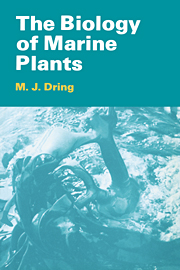Book contents
- Frontmatter
- Contents
- PREFACE
- ACKNOWLEDGEMENTS
- 1 MARINE PLANTS: TAXONOMIC, MORPHOLOGICAL AND ECOLOGICAL CATEGORIES
- 2 THE SEA AS AN ENVIRONMENT FOR PLANT GROWTH
- 3 PHOTOSYNTHESIS IN THE SEA
- 4 GROWTH AND PRODUCTIVITY OF MARINE PLANTS
- 5 MORPHOGENESIS OF MARINE PLANTS
- 6 THE ECOLOGY OF SEAWEEDS: ZONATION AND SUCCESSION
- 7 GEOGRAPHICAL DISTRIBUTION OF MARINE PLANTS
- 8 USES AND USAGE OF MARINE PLANTS
- 9 BACTERIA AND FUNGI IN THE SEA
- REFERENCES
- INDEX
5 - MORPHOGENESIS OF MARINE PLANTS
Published online by Cambridge University Press: 02 February 2010
- Frontmatter
- Contents
- PREFACE
- ACKNOWLEDGEMENTS
- 1 MARINE PLANTS: TAXONOMIC, MORPHOLOGICAL AND ECOLOGICAL CATEGORIES
- 2 THE SEA AS AN ENVIRONMENT FOR PLANT GROWTH
- 3 PHOTOSYNTHESIS IN THE SEA
- 4 GROWTH AND PRODUCTIVITY OF MARINE PLANTS
- 5 MORPHOGENESIS OF MARINE PLANTS
- 6 THE ECOLOGY OF SEAWEEDS: ZONATION AND SUCCESSION
- 7 GEOGRAPHICAL DISTRIBUTION OF MARINE PLANTS
- 8 USES AND USAGE OF MARINE PLANTS
- 9 BACTERIA AND FUNGI IN THE SEA
- REFERENCES
- INDEX
Summary
The discussion of morphology in Chapter 1 raised several fundamental questions about marine plants, such as why the algae should have developed more complex morphologies in the sea than in fresh water, and why, among photosynthetic plants, both pseudo-parenchymatous and siphonaceous thalli should be almost entirely confined to the sea. Another question that could be asked is why the marine algae as a group should show such an extraordinary diversity of life histories. The suggestion that the different morphologies, life histories and physiologies of marine algae represent ‘evolutionary experiments’ may, in a sense, be true, but it provides no more than a superficial answer to these questions. It fails to explain why these features have persisted — or continued to evolve — after the successful invasion of the land by parenchymatous plants, or why one of these marine experiments has not eliminated all others in the sea.
Current knowledge of the factors controlling algal morphology is far too rudimentary for us to be able even to see where the answers to such questions may lie, but the solution of these problems provides a long-term objective for studies of algal morphogenesis. Meanwhile, less far-reaching questions about how a particular environmental factor affects the morphology or the development of a particular species, or about the relative importance of genetics and the environment, provide the main stimulus for research.
- Type
- Chapter
- Information
- The Biology of Marine Plants , pp. 92 - 118Publisher: Cambridge University PressPrint publication year: 1991



